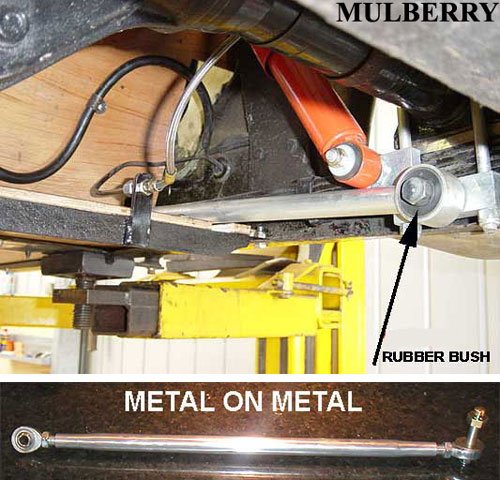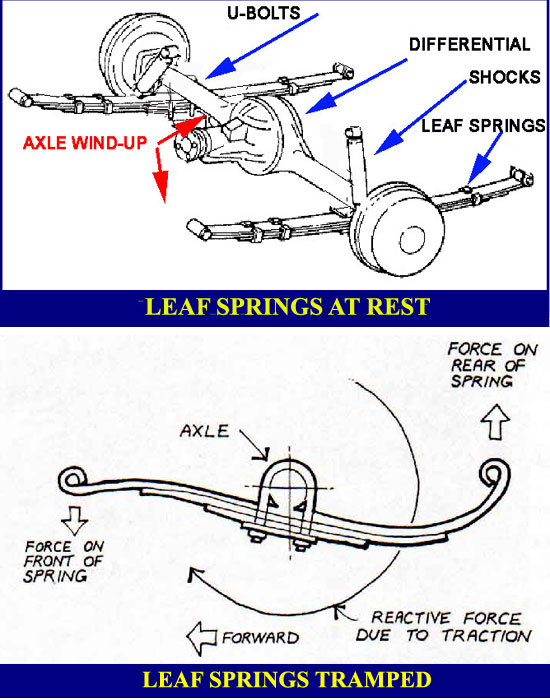 It can be cured with anti-tramp (aka traction) bars. But
one must take care not to throw out the baby with the bath water in choosing
them. Morgans have so little suspension travel that it is sad to ever limit it
with add-ons.
It can be cured with anti-tramp (aka traction) bars. But
one must take care not to throw out the baby with the bath water in choosing
them. Morgans have so little suspension travel that it is sad to ever limit it
with add-ons.  MUSINGS ON THE MORGAN REAR END (2006)
MUSINGS ON THE MORGAN REAR END (2006)Though many will disagree, Morgan trads, precisely adjusted to their original design and well-shod with good rubber, can provide a ride as comfortable as any I have experienced on any car. Forgive me but, sadly, most trads I have seen are anything but well-adjusted, either from the Factory and that gets worse as time goes on. So even the best of them can exhibit unpleasant characteristics. And as torque increases to more than 200 lbft+ this sadness can be more expressive. Of course, driver can get used to anything and incrementally accept this, and most do automatically and unconsciously. However, I believe that one should resist such tendancies. After all, this is a car you bought to have fun, so why allow yourself to make its arena get smaller unnecessarily?
The first phenomenon examined is called axle tramp. This is a form of rear wheel hop that occurs on cars with live axles, caused by the axle rotating with the wheels off a sudden agressive start and then violently springing back caused by the leaf springs returning to their proper form.
The Morgan rear is suspended at the wheels using long elliptical leaf springs at each side attached between two points fore and aft on the car's chassis, with the axle in their middle. In the normal course, these springs should allow the car to pleasantly interface with the road by absorbing impacts and moving the weight of the car up and down. However, when there is sufficiently high torque, a jackrabbit start will force the leaves to curl on themselves or "windup". When this happens, the axle tries to lift the fronts of the springs, and more noticeably, drops the rear ends. The axle twists the normally straight springs into an S-shape, and the rear wheels start to hop up and down. This diminishes their traction and causes them to bounce and chatter violently. Additionally, the normally straight drive shaft from the front is forced to angle up to meet the now angled differential's input shaft, and power train performance is seriously affected. With some Morgans, the movement of the axle is so extreme, that it causes the propshaft to impact the tunnel or worse. (See Roadster Anti-Tramp Issue)
 It can be cured with anti-tramp (aka traction) bars. But
one must take care not to throw out the baby with the bath water in choosing
them. Morgans have so little suspension travel that it is sad to ever limit it
with add-ons.
It can be cured with anti-tramp (aka traction) bars. But
one must take care not to throw out the baby with the bath water in choosing
them. Morgans have so little suspension travel that it is sad to ever limit it
with add-ons.
Normally, these bars are hefty rigid items or tubes of tempered steel with pivoted holding brackets on both ends. The front ends of the bars connect to the front spring mounts on the vehicle frame. The rear brackets bolt to the bottom of the drive axle at the axle u-bolt saddle plate. These bars will keep the axle from twisting backwards while it forces the drive wheels to turn forwards, completely eliminating leaf spring windup, and keeping the rear drive wheels forced down to the pavement for superior traction.
However, many bars will prejudice your rear suspension. They have adjustable metal brackets at both ends and these are adjusted to eliminate play. In doing so, they also limit some of the up and down movement your leaf springs need to do their job. Peter Mulberry has an excellent solution which many use (and the Factory tried to copy [badly] to the misery of early Roadsters) which solves this issue. Instead of only an adjustable bracket at the rear, Peter has designed a fitting that is contained within a rubber "doughnut". This eliminates tramp while still allowing full suspension movement. See the picture to the left to see the differences between the two types.
Installation is not complicated...only long. The seats
must be removed to properly access the front leaf spring eyelet and add the
forward anti-tramp fitting. The leaf springs must be unbolted at the axle
and Mulberry's special plate (with stronger, longer u-bolts and a threaded
hole for the anti-tramp bar) swapped in. I have found that the rubber doughnuts
wear after about 25,000 miles but it is not difficult to remove the rear
section of the bars and have the old doughnuts pressed out and new pressed
in. I did it myself using my table vice.
| WATCHPOINT: Despite the logic against such a move, when the Roadster problem appeared the Factory decided to fit only a single anti-tramp bar on the right rather than a bar per side as is the proper format dictated by correct automobile engineering. Their then new battery placement was in the way on the opposite side and they knew there would be substantial savings with a single bar, rather using a set of Mulberry originals that they used on Morgan racing models. The sad results of their decision here have been threefold. 1. Their copies of the Mulberry sheared off costing the company an immense outlay in warranty repairs. 2. A single bar will rapidly wear one side of the suspension and not the other. 3. Morgan owners are now of the false impression that a single anti-tramp bar is normal. In fact, unless such a bar is attached to the differential, this notion is sad silliness. |